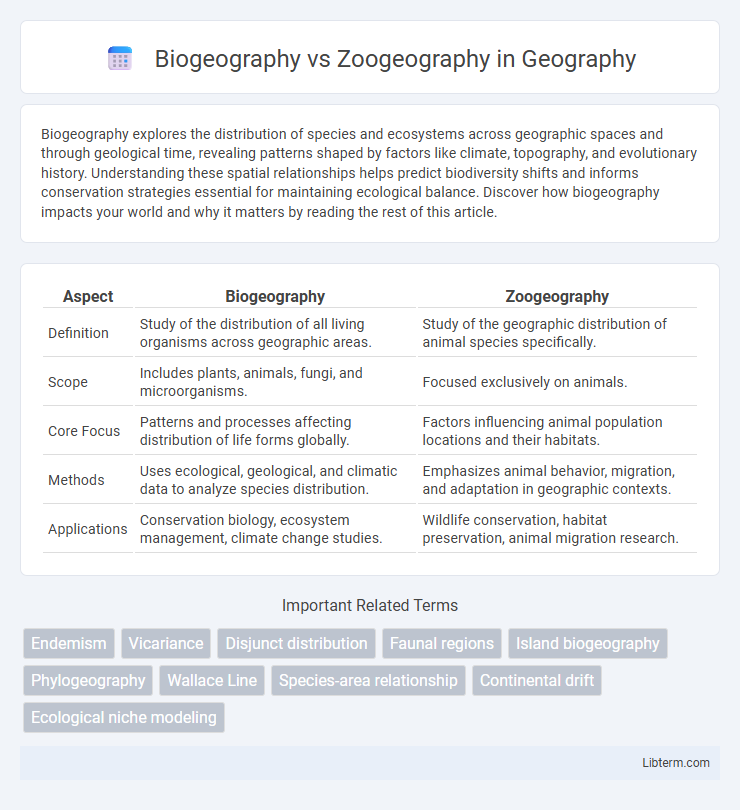Biogeography explores the distribution of species and ecosystems across geographic spaces and through geological time, revealing patterns shaped by factors like climate, topography, and evolutionary history. Understanding these spatial relationships helps predict biodiversity shifts and informs conservation strategies essential for maintaining ecological balance. Discover how biogeography impacts your world and why it matters by reading the rest of this article.
Table of Comparison
| Aspect | Biogeography | Zoogeography |
|---|---|---|
| Definition | Study of the distribution of all living organisms across geographic areas. | Study of the geographic distribution of animal species specifically. |
| Scope | Includes plants, animals, fungi, and microorganisms. | Focused exclusively on animals. |
| Core Focus | Patterns and processes affecting distribution of life forms globally. | Factors influencing animal population locations and their habitats. |
| Methods | Uses ecological, geological, and climatic data to analyze species distribution. | Emphasizes animal behavior, migration, and adaptation in geographic contexts. |
| Applications | Conservation biology, ecosystem management, climate change studies. | Wildlife conservation, habitat preservation, animal migration research. |
Introduction to Biogeography and Zoogeography
Biogeography studies the distribution of all living organisms across the Earth's surface, encompassing plants, animals, and microorganisms, and the ecological and evolutionary factors influencing their geographic patterns. Zoogeography, a sub-discipline of biogeography, specifically focuses on the spatial distribution and diversity of animal species, analyzing factors such as habitat preferences, migration, and historical biotic events affecting fauna. Both fields utilize geographic, climatic, and tectonic data to explain species distribution but differ in their scope--biogeography covers all life forms, while zoogeography concentrates exclusively on animals.
Defining Biogeography
Biogeography examines the distribution of all living organisms across geographical spaces, integrating ecological and historical factors to explain patterns of biodiversity. It encompasses both flora and fauna, analyzing interactions between species and their environments on various scales. Zoogeography, as a subset of biogeography, specifically focuses on the spatial distribution of animal species and their ecological and evolutionary relationships.
Defining Zoogeography
Zoogeography is a branch of biogeography that specifically studies the geographic distribution of animal species and populations across spatial and temporal scales. It examines patterns influenced by ecological, evolutionary, climatic, and geographical factors shaped by continental drift, habitat fragmentation, and species migration. Zoogeography helps in understanding biodiversity hotspots, endemism, and the impact of environmental changes on animal distribution.
Key Differences Between Biogeography and Zoogeography
Biogeography studies the distribution of all living organisms, including plants, animals, and microorganisms, across geographical areas and ecosystems, while zoogeography specifically focuses on the spatial distribution of animal species and their habitats. Biogeography integrates multiple biological disciplines and environmental factors influencing species dispersal, whereas zoogeography concentrates on patterns related to animal groups, migration, and evolutionary history. The key difference lies in the scope, with biogeography encompassing a broader spectrum of life forms and ecological interactions compared to zoogeography's exclusive emphasis on fauna.
Historical Development of Each Discipline
Biogeography originated in the early 19th century with Alexander von Humboldt's exploration of species distribution patterns across different climates, emphasizing plant geography and ecosystem diversity. Zoogeography, a subset of biogeography, gained prominence in the mid-19th century through Alfred Russel Wallace's studies on animal distribution and faunal regions, significantly advancing understandings of evolutionary biology and species migration. Both disciplines evolved through integrative approaches combining geological history, climate change, and phylogenetic relationships to explain spatial biodiversity patterns.
Methodologies in Biogeography and Zoogeography
Biogeography employs methodologies such as species distribution modeling, phylogenetic analysis, and GIS mapping to study the spatial patterns of all organisms, integrating both historical and ecological data. Zoogeography focuses more specifically on animal distribution, utilizing techniques like faunal surveys, ecological niche modeling, and paleontological records to analyze animal populations in relation to environmental variables. Both fields rely heavily on remote sensing and molecular data but differ in scope, with biogeography addressing broader biodiversity patterns while zoogeography centers exclusively on animals.
Importance of Biogeography in Ecology
Biogeography plays a critical role in ecology by examining the spatial distribution of species and ecosystems across geographic areas, thereby informing conservation strategies and biodiversity management. Unlike zoogeography, which specifically focuses on animal distribution, biogeography encompasses both flora and fauna, providing a comprehensive understanding of ecological patterns and processes. Its insights help predict environmental changes' impacts on species distribution, supporting ecosystem resilience and sustainability efforts.
Role of Zoogeography in Understanding Animal Distribution
Zoogeography plays a crucial role in understanding animal distribution by analyzing the geographic spread and habitat preferences of various species. It examines patterns shaped by ecological factors, evolutionary history, and environmental changes to explain how animals adapt and disperse across continents. Insights from zoogeography inform conservation strategies by identifying biodiversity hotspots and migration corridors essential for species survival.
Applications in Conservation and Environmental Science
Biogeography and zoogeography provide critical insights for conservation planning by mapping species distributions and identifying biodiversity hotspots, which guide habitat protection and restoration efforts. Biogeography emphasizes patterns across all living organisms and ecosystems, supporting landscape-level conservation strategies, while zoogeography focuses specifically on animal populations, aiding in wildlife management and species-specific recovery programs. Integrating these disciplines enhances environmental science by improving predictions of species responses to climate change and human impacts, ensuring targeted and effective conservation policies.
Future Trends in Biogeography and Zoogeography Research
Future trends in biogeography and zoogeography research emphasize the integration of advanced genomic tools and remote sensing technologies to map species distributions and evolutionary histories with higher precision. The application of machine learning algorithms enables predictive modeling of biodiversity responses to climate change, habitat fragmentation, and human activities. Collaborative global databases and real-time ecological monitoring systems are enhancing the ability to track biogeographic and zoogeographic shifts, supporting conservation strategies in rapidly changing environments.
Biogeography Infographic

 libterm.com
libterm.com